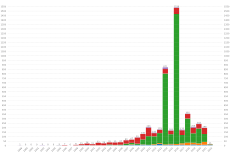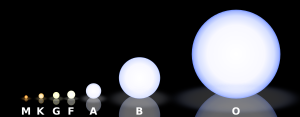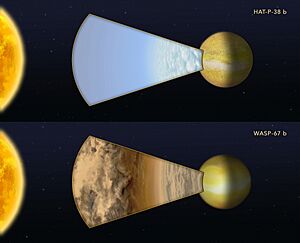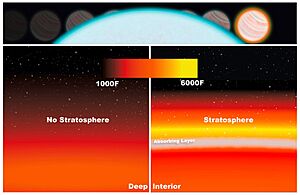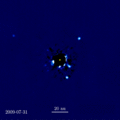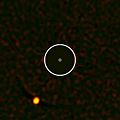Extrasolar planet facts for kids
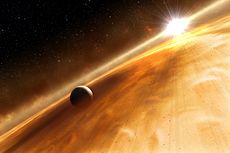
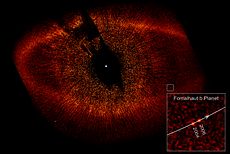
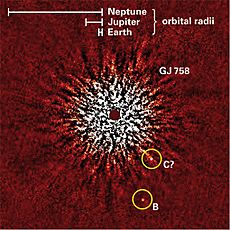
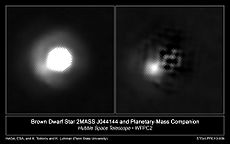
An extrasolar planet (or exoplanet) is a natural planet that orbits a star outside our own solar system. Think of them as planets in other star systems!
Scientists believe there are billions of planets in our Milky Way galaxy alone. Some estimates suggest there could be at least 17 billion terrestrial planets (rocky planets like Earth). The Kepler space observatory found many planet candidates. Among them were 461 Earth-sized planets. At least four of these are in the "habitable zone". This is where liquid water could exist. One of these, called Kepler-69c, is only 1.5 times the size of Earth. It orbits a star similar to our Sun. This makes it a strong candidate for an "Earth 2.0".
There are also planets that orbit brown dwarfs. These are objects bigger than planets but smaller than stars. Some planets even float freely in space. They don't orbit any star! It's still debated if these should be called "planets". Most known exoplanets are very different from the planets in our solar system. For example, some are called "hot Jupiters". These are giant planets that orbit very close to their stars.
Contents
Discovering Exoplanets
Early Ideas About Other Planets
People have wondered about planets outside our solar system for a long time. In the 1500s, an Italian thinker named Giordano Bruno believed that other stars were like our Sun. He thought they also had planets orbiting them. For his ideas, Bruno was sadly burned at the stake.
Later, in the 1700s, Isaac Newton also thought about this. He wrote that if other stars were like our Sun, they might have their own planet systems too.
First Confirmed Discoveries
The first confirmed discovery of an exoplanet was announced in 1988. It was finally confirmed in 1992. In 1992, astronomers found planets orbiting a pulsar. A pulsar is a very dense, spinning star that sends out radio waves. These "pulsar planets" might have formed from the leftover material after a supernova. A supernova is a huge star explosion.
A big moment came on October 6, 1995. Scientists Michel Mayor and Didier Queloz found an exoplanet orbiting a normal star. This star is called 51 Pegasi. This discovery changed everything! It started the modern age of finding exoplanets. New technology helped astronomers find many more. They could detect exoplanets by watching their gravitational pull on their stars. They also found them by watching occultations. This is when a planet passes in front of its star, making the star look dimmer.
By May 2016, NASA announced over 1,284 new exoplanets. This brought the total number to more than 3,000!
How Exoplanets Form and Change
Planets can form quite quickly, within a few to tens of millions of years after their star forms. We can only see the planets in our solar system as they are now. But by looking at other planetary systems of different ages, we can see planets at various stages of their lives.
When planets form in a gassy disk around a young star, they gather hydrogen and helium. Over time, these gas layers cool down and shrink. Some or all of the gas can even escape into space. This means that even rocky planets might start out very large if they form early. For example, Kepler-51b is only twice the mass of Earth. But it's almost the size of Saturn, which is 100 times more massive! Kepler-51b is quite young, only a few hundred million years old.
Stars That Host Planets
On average, there is at least one planet for every star. About 1 in 5 stars similar to our Sun have an "Earth-sized" planet in the habitable zone.
Most known exoplanets orbit stars like our Sun. These are called main-sequence stars of types F, G, or K. Smaller stars, called red dwarfs (type M), are less likely to have very massive planets. However, the Kepler telescope has found many smaller planets around red dwarfs. It uses the transit method to find them.
Scientists have also found a link between a star's "metallicity" and its chance of having giant planets. Metallicity refers to how many elements heavier than hydrogen and helium a star contains. Stars with more metals are more likely to have planets, especially giant ones like Jupiter.
Some planets orbit one star in a binary star system (two stars orbiting each other). Some "circumbinary planets" even orbit both stars! A few planets are known in systems with three stars, and one in a system with four stars (Kepler-64).
General Features of Exoplanets
Color and Brightness
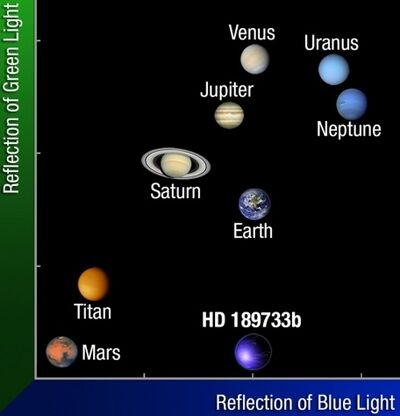
In 2013, scientists figured out the color of an exoplanet for the first time. The planet HD 189733b appears a deep dark blue. Later, other exoplanets' colors were found. GJ 504 b looks magenta, and Kappa Andromedae b would look reddish up close. Planets made mostly of helium might look white or gray.
A planet's brightness depends on how far away it is. It also depends on how much light it reflects (its albedo). And how much light it gets from its star. A planet that is very dark but close to its star can still appear brighter than a reflective planet far away.
The darkest known planet is TrES-2b. It's a hot Jupiter that reflects less than 1% of its star's light. That's darker than coal! Scientists aren't sure why it's so dark.
Magnetic Fields
In 2014, scientists found signs of a magnetic field around HD 209458 b. They saw hydrogen escaping from the planet in a certain way. This was the first indirect sign of a magnetic field on an exoplanet. It's thought to be about one-tenth as strong as Jupiter's.
Strong magnetic fields on giant planets are likely caused by liquid metallic hydrogen deep inside them. This is similar to how Earth's magnetic field is made by its liquid metallic core.
Plate Tectonics
Plate tectonics is how Earth's outer shell is broken into large plates that move. In 2007, scientists had different ideas about plate tectonics on larger "super-Earths." Some thought it would be rare. Others thought it was very likely, even if the planet was dry.
If a super-Earth has more than 80 times the water of Earth, it would be an ocean planet. All land would be underwater. But with less water, continents could still exist.
Volcanic Activity
Big temperature changes on 55 Cancri e might be due to volcanoes. These volcanoes could release huge clouds of dust. The dust would then cover the planet and block heat.
Rings
The star 1SWASP J140747.93-394542.6 has an object orbiting it with a huge ring system. It's much bigger than Saturn's rings. We don't know the object's mass yet. It could be a brown dwarf or a low-mass star, not just a planet.
The brightness of Fomalhaut b could be from starlight reflecting off a ring system. This ring system might be 20 to 40 times the size of Jupiter's radius. That's about the size of the orbits of Jupiter's Galilean moons.
Moons
In 2013, a possible exomoon was found orbiting a rogue planet. A rogue planet doesn't orbit any star. In 2018, there was evidence of a large exomoon orbiting Kepler-1625b.
Atmospheres
Scientists have found atmospheres around several exoplanets. The first one observed was around HD 209458 b in 2001.
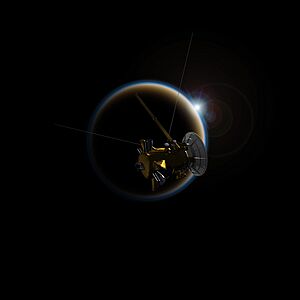
By 2014, atmospheres of over 50 exoplanets had been studied. Scientists could see different molecules in their air. They also measured temperature differences between the day and night sides.
Comet-like Tails
KIC 12557548 b is a small, rocky planet very close to its star. It's actually evaporating! It leaves a tail of cloud and dust, just like a comet. This dust could be ash from volcanoes. Or it could be metals that vaporize from the star's heat.
In 2015, scientists reported that the atmosphere of GJ 436 b was evaporating. This created a giant cloud around the planet. It also made a long tail, about 9 million miles long, due to radiation from its star.
How Sunlight Hits the Planet
Some planets are "tidally locked". This means one side always faces its star, like our Moon always shows us the same side of Earth. This side would be super hot, and the other side would be freezing cold. Such a planet might look like an eyeball, with the hot spot as the pupil.
Exoplanet Surfaces
Surface Composition
Scientists can tell if a planet has a rocky surface or a gassy atmosphere. They do this by looking at how light interacts with the planet. Mid-infrared light can show rocky surfaces. Near-infrared light can show magma oceans, lava, or water ice. This helps tell rocky planets from gas giants.
Surface Temperature
We can guess an exoplanet's temperature by how much light it gets from its star. For example, OGLE-2005-BLG-390Lb is thought to have a surface temperature of about -220°C (50 K). But this can be tricky. We don't always know how reflective the planet is. Also, the greenhouse effect can change temperatures.
Some planets have had their temperature measured more directly. Scientists watch how much infrared light they give off as they orbit. For example, HD 189733b has a day side temperature of about 932°C (1,205 K). Its night side is about 700°C (973 K).
Is There Life Out There?
As we find more planets, the study of exoplanets grows. One big question is: can life exist on planets beyond our solar system? We can only detect life if it has greatly changed its planet's environment. For example, the oxygen in Earth's atmosphere comes from living things. So, oxygen could be a sign of life on other planets.
A planet that might support life must orbit a stable star. It needs to be at a distance where liquid water can exist on its surface. This is called the habitable zone.
The Habitable Zone
The habitable zone around a star is like a "sweet spot." It's not too close to the star (so water doesn't boil away). And it's not too far (so water doesn't freeze solid). The size and age of a star change where this zone is. Also, a planet's atmosphere affects how much heat it keeps.
For example, "desert planets" with little water would have less water vapor. This means a weaker greenhouse effect. So, they could have liquid water closer to their star than Earth is to the Sun. Planets with thick hydrogen atmospheres could have surface water much farther out. Larger planets have wider habitable zones. This is because their gravity affects how water clouds form.
Planets that spin slowly can create thick clouds. These clouds reflect more sunlight. So, these planets can be habitable even closer to their star.
Even planets that are tidally locked (one side always faces the star) can be habitable. Thick water clouds can form on the hot side. These clouds reflect sunlight and keep the surface cooler.
The habitable zone is usually defined by surface temperature. But over half of Earth's living things are microbes underground! Temperatures increase with depth. So, liquid water could exist deep underground even if the surface is frozen. This means the habitable zone could extend much farther from a star. Even rogue planets could have underground oceans. Also, giant planets like Jupiter might not be habitable themselves. But they could have habitable moons.
Ice Ages and Snowball States
The outer edge of the habitable zone is where planets are completely frozen. But planets well inside this zone can also freeze over sometimes. If a planet cools, more ice forms. Ice reflects sunlight, which causes even more cooling. This can lead to a "snowball state" where the planet is almost completely frozen.
When the surface is frozen, carbon dioxide from volcanoes builds up in the atmosphere. This creates a strong greenhouse effect that eventually thaws the planet. Planets with a large axial tilt (like Earth's tilt) are less likely to enter snowball states. They can keep liquid water farther from their star.
Tidal Heating
If a planet has an eccentric (oval-shaped) orbit, it can get extra heat from tidal heating. This is caused by the star's gravity pulling on the planet differently as it gets closer and farther away. This means eccentric planets in the habitable zone could be too hot for liquid water.
Tidal heating can also cause gases to escape from a planet's interior. This can help form or refresh an atmosphere.
Types of Exoplanets
Extrasolar planets come in many different forms:
- They can be gas giants (like Jupiter) or rocky planets (like Earth).
- They might even be dwarf planets, which are smaller and less dense than regular planets.
- They can orbit different kinds of stars.
- Some are free-floating or orbit a brown dwarf.
- Some might even support life! For example, Gliese 581g was once thought to possibly support life, but its existence is not fully confirmed.
Closest Exoplanets
The closest star with planets is Alpha Centauri. It's about 4.3 light years away. With today's rockets, it would take tens of thousands of years to get there!
The closest star similar to our Sun is Tau Ceti. It has five planets. One of them is in the habitable zone, where liquid water might exist.
Most Earth-like Planets
Some exoplanets might be very similar to Earth. Scientists use a score called the Earth Similarity Index (ESI) to rank them. The ESI goes from 1 (most Earth-like) to 0 (least Earth-like). For a planet to be considered potentially habitable, it should have an ESI of at least 0.8. Here's a list comparing some exoplanets to our own solar system's rocky planets:
| Name | ESI | SFV | HZD | COM | ATM | Planet type | Star | Habitability | Distance (ly) | Status | Year of discovery |
Ref |
|---|---|---|---|---|---|---|---|---|---|---|---|---|
| Earth | 1.00 | 0.72 | −0.50 | −0.31 | −0.52 | warm terran | G | mesoplanet | 0 | Non-exoplanet, inhabited | prehistoric | |
| Kepler-438b | 0.88 | 0.88 | −0.93 | −0.14 | −0.73 | warm terran | M | mesoplanet | 472.9 | confirmed | 2015 | |
| Kepler-1410b | 0.88 | 0.63 | −0.88 | −0.16 | −0.06 | warm superterran | K | mesoplanet | 1213.4 | confirmed | 2011 | |
| Gliese 667 Cc | 0.84 | 0.64 | −0.62 | −0.15 | +0.21 | warm terran | M | mesoplanet | 23.6 | confirmed | 2011 | |
| Kepler-442b | 0.83 | 0.98 | −0.72 | −0.15 | +0.28 | warm superterran | K | mesoplanet | 1291.6 | confirmed | 2015 | |
| Kepler-62e | 0.83 | 0.96 | −0.70 | −0.15 | +0.28 | warm superterran | K | mesoplanet | 1199.7 | confirmed | 2013 | |
| Kepler-452b | 0.83 | 0.93 | −0.61 | -0.15 | -0.30 | warm superterran | G | mesoplanet | 1402.5 | confirmed | 2015 | |
| Gliese 832 c | 0.81 | 0.96 | −0.72 | −0.15 | +0.43 | warm superterran | M | mesoplanet | 16.1 | confirmed | 2014 | |
| Kepler-283c | 0.79 | 0.85 | −0.58 | −0.14 | +0.69 | warm superterran | K | mesoplanet | 1496.8 | confirmed | 2011 | |
| Kepler-436b | 0.79 | 0.33 | −0.87 | −0.14 | +0.47 | warm superterran | M | mesoplanet | 1339.4 | confirmed | 2015 | |
| Kepler-1229b | 0.79 | 0.00 | −0.40 | −0.15 | +0.44 | warm superterran | M | mesoplanet | 769.7 | confirmed | 2016 | |
| Tau Ceti e | 0.78 | 0.00 | −0.92 | −0.15 | +0.16 | warm superterran | G | mesoplanet | 11.9 | unconfirmed | 2012 | |
| Kepler-296f | 0.78 | 0.15 | −0.90 | −0.14 | +0.53 | warm superterran | M | mesoplanet | 1089.6 | confirmed | 2011 | |
| Gliese 180 c | 0.77 | 0.42 | −0.53 | −0.14 | +0.64 | warm superterran | M | mesoplanet | 39.5 | unconfirmed | 2014 | |
| Gliese 667 Cf | 0.77 | 0.00 | -0.22 | −0.16 | +0.08 | warm terran | M | psychroplanet | 23.6 | dubious | 2013 | |
| Gliese 581 g | 0.76 | 1.00 | -0.70 | −0.15 | +0.28 | warm superterran | M | mesoplanet | 20.2 | dubious | 2010 | |
| Gliese 163 c | 0.75 | 0.02 | −0.96 | −0.14 | +0.58 | warm superterran | M | mesoplanet | 48.9 | confirmed | 2012 | |
| Gliese 180 b | 0.75 | 0.41 | −0.88 | −0.14 | +0.74 | warm superterran | M | mesoplanet | 39.5 | unconfirmed | 2014 | |
| HD 40307 g | 0.74 | 0.04 | −0.23 | −0.14 | +0.77 | warm superterran | K | psychroplanet | 41.7 | confirmed | 2012 | |
| Kepler-61b | 0.73 | 0.27 | −0.88 | −0.13 | +1.24 | warm superterran | M | mesoplanet | 1062.8 | confirmed | 2013 | |
| Kepler-443b | 0.73 | 0.91 | −0.49 | −0.13 | +1.44 | warm superterran | K | mesoplanet | 2564.4 | confirmed | 2015 | |
| Gliese 422 b | 0.71 | 0.17 | −0.41 | −0.13 | +1.11 | warm megaterran | M | mesoplanet | 41.3 | unconfirmed | 2014 | |
| Kepler-22b | 0.71 | 0.53 | −0.64 | −0.12 | +1.79 | warm superterran | G | mesoplanet | 619.4 | confirmed | 2011 | |
| Kepler-440b | 0.70 | 0.00 | +0.01 | −0.15 | +0.38 | warm superterran | K | psychroplanet | 706.5 | confirmed | 2015 | |
| Kepler-298d | 0.68 | 0.00 | −0.86 | −0.11 | +2.11 | warm superterran | K | mesoplanet | 1545 | confirmed | 2012 | |
| Kepler-439b | 0.68 | 0.00 | −0.99 | −0.13 | +1.18 | warm superterran | G | thermoplanet | 1914.8 | confirmed | 2015 | |
| Kapteyn b | 0.67 | 0.00 | +0.08 | −0.15 | +0.57 | warm superterran | M | psychroplanet | 12.7 | unconfirmed | 2014 | |
| Kepler-62f | 0.67 | 0.05 | +0.45 | −0.16 | +0.19 | warm superterran | K | psychroplanet | 1199.7 | confirmed | 2013 | |
| Kepler-186f | 0.64 | 0.00 | +0.48 | −0.17 | −0.26 | warm terran | M | psychroplanet | 492 | confirmed | 2014 | |
| Kepler-174d | 0.61 | 0.00 | +0.32 | −0.13 | +1.77 | warm superterran | K | confirmed | 2011 | |||
| Gliese 667 Ce | 0.60 | 0.00 | +0.51 | −0.16 | +0.23 | warm terran | M | psychroplanet | 23.6 | dubious | 2013 | |
| Gliese 682 c | 0.59 | 0.00 | +0.22 | −0.14 | +1.19 | warm superterran | M | psychroplanet | 16.6 | unconfirmed | 2014 | |
| Gliese 581 d | 0.53 | 0.00 | +0.78 | −0.14 | +0.94 | warm superterran | M | hypopsychroplanet | 20.2 | unconfirmed | 2007 | |
| Kepler-155c | K | - | confirmed | |||||||||
| Venus | 0.78 | 0.00 | −0.93 | −0.28 | −0.70 | warm terran | G | hyperthermoplanet | close to zero | non-exoplanet | prehistoric | |
| Mars | 0.64 | 0.00 | +0.33 | −0.13 | −1.12 | warm subterran | G | hypopsychroplanet | close to zero | non-exoplanet | prehistoric | |
| Mercury | 0.39 | 0.00 | −1.46 | −0.52 | −1.37 | hot mercurian | G | non-habitable | close to zero | non-exoplanet | prehistoric |
Potentially Habitable Planets
In 2015, scientists named Kepler-62f, Kepler-186f, and Kepler-442b as the best candidates for being potentially habitable. These planets are very far away. Kepler-186f is about 490 light-years away. It's similar in size to Earth and orbits a red dwarf star. It's located near the outer edge of its star's habitable zone.
The closest potentially habitable exoplanet candidate is Proxima Centauri b. It's only about 4.2 light-years away. Its temperature is estimated to be around -39°C.
Earth-sized Planets
- In 2013, scientists thought that about 22% of Sun-like stars in the Milky Way might have an Earth-sized planet in the habitable zone. If there are 200 billion stars in our galaxy, that means 11 billion potentially habitable Earths! If we include red dwarfs, that number could rise to 40 billion.
- Kepler-186f, a planet 1.2 times Earth's radius, was found in 2014. It's in the habitable zone of a red dwarf.
- Proxima Centauri b is a planet in the habitable zone of Proxima Centauri. This is the closest known star to our solar system. It's estimated to be at least 1.27 times the mass of Earth.
- In 2013, scientists thought that up to 6% of small red dwarfs might have Earth-sized planets. This means the closest one could be just 13 light-years away.
- Kepler-452b is 1.63 times Earth's radius. It was the first near-Earth-sized planet found in the "habitable zone" around a G2-type star, like our Sun (in July 2015).
Related Pages
Images for kids
-
Coronagraphic image of AB Pictoris showing a companion (bottom left), which is either a brown dwarf or a massive planet. The data was obtained on 16 March 2003 with NACO on the VLT, using a 1.4 arcsec occulting mask on top of AB Pictoris.
See also
 In Spanish: Planeta extrasolar para niños
In Spanish: Planeta extrasolar para niños


